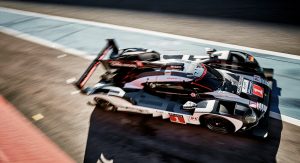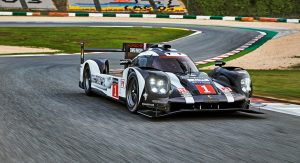This is Porsche’s new Le Mans contender, the 2016 919 Hybrid LMP1 racer designed to meet the new regulations of the WEC racing series.
Porsche is the only manufacturer this year that chose to compete in the 8 Megajoules class, FIA’s highest recuperation category which restricts the amount of used fuel per lap to 4.31 liters in petrol and 3.33 liters in diesel-powered race cars.
This means that the new Porsche 919 Hybrid’s turbocharged 2.0-litre V4 engine will now drop its output to below 500hp, with engineers looking for other ways to generate more power from less fuel.
Porsche is using two energy recuperation systems in the 919 Hybrid, with the front-mounted converting braking into electric power and the rear mounted on the exhaust tract where the exhaust gasses drive a second turbine in parallel with the turbocharger, using the excess energy from the exhaust pressure that would otherwise escape into the environment.
This additional turbine is connected to an electric generator which stores the produced energy in a lithium-ion battery pack. It’s an innovative adaptation of the variable turbine geometry technology which allows the turbines to be driven, even at low engine revs and low pressure.
All the electric power produced -the front KERS and the rear exhaust turbine- is applied to the front axle when the driver need it, providing an extra 400hp and turning temporarily the 919 Hybrid into an all-wheel drive race car with around 900hp.
You don’t need us to tell you that all this wizardry has a very important meaning for the real world, as manufacturers like Porsche are keen to transfer these technologies into our future road cars. Who wouldn’t want a hybrid like this?



![Porsche Reveals 2016 919 Hybrid LMP1 Racer [w/Video]](https://www.carscoops.com/wp-content/uploads/2024/04/Hyundai-Ioniq-5-N-1024x576.jpg)
![Porsche Reveals 2016 919 Hybrid LMP1 Racer [w/Video]](https://www.carscoops.com/wp-content/uploads/2024/04/2025-Toyota-4Runner-80-Stephen-Rivers-for-Carscoops-copy-1024x576.jpg)
![Porsche Reveals 2016 919 Hybrid LMP1 Racer [w/Video]](https://www.carscoops.com/wp-content/uploads/2024/04/2025_Toyota_4Runner_TRDPro_Mudbath_049-copy-1024x576.jpg)
![Porsche Reveals 2016 919 Hybrid LMP1 Racer [w/Video]](https://www.carscoops.com/wp-content/uploads/2024/04/ythgvf-1024x576.jpg)
![Porsche Reveals 2016 919 Hybrid LMP1 Racer [w/Video]](https://www.carscoops.com/wp-content/uploads/2023/06/ForCarscoops-1024x683.jpg)
![Porsche Reveals 2016 919 Hybrid LMP1 Racer [w/Video]](https://www.carscoops.com/wp-content/uploads/2016/03/open-15.jpg)











